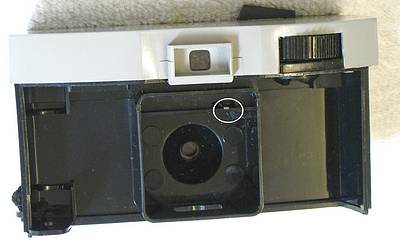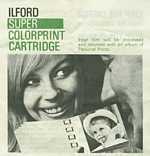| ILFORD Ilfomatic Compact, around 1966 |
|
|
Camera on loan, courtesy of David Muggleton. |
|
|
|
| There is no mistaking the similarity of the Ilfomatic Compact taking 126 cartridge film (above; also other pictures on this page) and the IlfordSprite Rapid Flash (immediately below) using the Agfa Rapid twin cassette 35mm film loading system. The obvious difference, apart from the film format, is that the Ilfomatic Compact 25 has no built-in flash or indeed any synchronisation means to fire a flash bulb. |
Since the IlfordSprite Rapid is known to have been made by Agilux in Croydon and the Ilfomatic Compact is embossed "Made in England" on its black plastic base, it is highly likely that the Ilfomatic Compact was also an Agilux product. The whole of the back of the Ilfomatic Compact is removeable after twisting the base turnkey from 'Lock' to 'Open'. |
|
|
|
| Compare the pictures above and below. Both have the same convex/concave back shape and both have a simple two-aperture exposure system, bright or dull (Ilfomatic Compact), bright or flash (Sprite Rapid Flash). It's curious why the Ilfomatic Compact has no built-in flash or flash cube socket or even a flash plug synchronisation socket. |
Below, a rear view of the Ilfomatic Compact, showing the knurled thumb wind for the film advance, the viewfinder rear eyepiece (giving a view slightly below life-size) and the exposure counter window for the Instamatic film cartridge. To the top right can be seen the black shutter release lever. |
|
|
|
|
For a pdf showing the leaflet
alongside (Dec 1966), a processing voucher and a further 126
Ilford film leaflet, A year previous, Ilford had started supplying their film in the Agfa Rapid cassette system, for the Sportina Rapid and Sprite Rapid cameras. Agfa had re-released this cassette system to counter Kodak's 126 Instamatic cartridge system and Ilford initially supported Agfa in this 'format war'. But, by Spring 1966, Ilford decided to 'back both horses'. This extract from Camera Magazine for March 1966 (Editor's Notebook) entitled "Rapid Colour" explains: |
|
|
Cartridge label dated F67 = June 1967 |
"Who's putting all their eggs in one basket? Certainly not a famous firm situated somewhere to the east of Forest Gate, London (meaning Ilford). To mix metaphors like a rotary whisk, they have extracted their digits from the egg basket and plunged them firmly into a goodly number of pies. Take, for a start, Rapid. A limited launch of Rapid cameras last year (1965) was so encouraging (prophets of gloom about this system notwithstanding) that this year they will be selling Rapid cameras and films on a national scale. Good for Rapid, say I. It's a natty system. And if you are fortunate enough to have a Rapid camera already, you will be able to load it with a new super colour film, from the same firm... BUT; Rapid has a rival, dare I say it, in Instamatic. So what does this famous firm do? They produce a film in Instamatic cartridges of course, then sit back and wait to see how well it all goes. Clever! " |
| With the Ilfomatic Compact being physically so similar to the Ilford Sprite Rapid Flash, it is natural to conjecture whether the Ilfomatic Compact was Ilford's first venture into 126 cartridge loading cameras before importing their 1967 Ilfomatic range from Hong Kong, or whether, having decided that the 126 vs Rapid format 'war' had been lost in favour of 126, the Ilfomatic was a conversion of unsold Sprite Rapid camera bodies to 126 cartridge loading. If the latter, however, it makes even less sense that the Ilfomatic Compact came without the Sprite Rapid's built-in flash. So the most likely is the former i.e. the Ilfomatic Compact was Ilford's first attempt (in 1966) to enter the 126 cartridge camera market, using a design that was as simple and low cost as possible, hence no flash gun. Later, the cheaper imported Ifomatics enabled the inclusion of flash, while maintaining cost competitiveness with the Kodak Instamatic range. | |
 |
 |
| With the back of the Ilfomatic Compact removed, the camera's drop-in film chamber can be seen. The white circle in the left hand picture has been superimposed over the metal lever which engages with the film's sprocket holes to enable the shutter to be released. The lever contacts the film sprocket holes via the slot shown circled on the film cartridge, right hand picture. By this means, the film wind-on is semi-automatic; you wind the knurled black thumb-wheel until it 'locks'; the film frame is then in position and the shutter can be fired. After that, the shutter cannot be fired again until the thumb-wheel has brought the next film frame into position. The number of exposures taken on the 12 exposure cartridge can be seen by viewing the frame number on backing paper visible through the small central window of the cartridge (below, left) and, hence, through the rear clear window of the camera back (below, right). | |
|
|
|
|
|
Another Ilfomatic Compact, this one looking much more like the Ilfomatic range of 126 cartridge loading cameras, within which range it actually belongs. The word 'Compact' in its name title seems to signify a bottom of the range version. It was made in Hong Kong. Amateur Photographer magazine for 3rd December 1969 lists the Ilfomatic Compact as the simplest of the Ilfomatics. It had a fixed aperture lens, a single speed shutter and only an accessory shoe to enable taking flash pictures by means of a separate flash gun. The Ilfomatic Compact sold for £2.14s (£2.70p) in December 1969. Picture courtesy of David Muggleton |
|
|
|||
|
|
